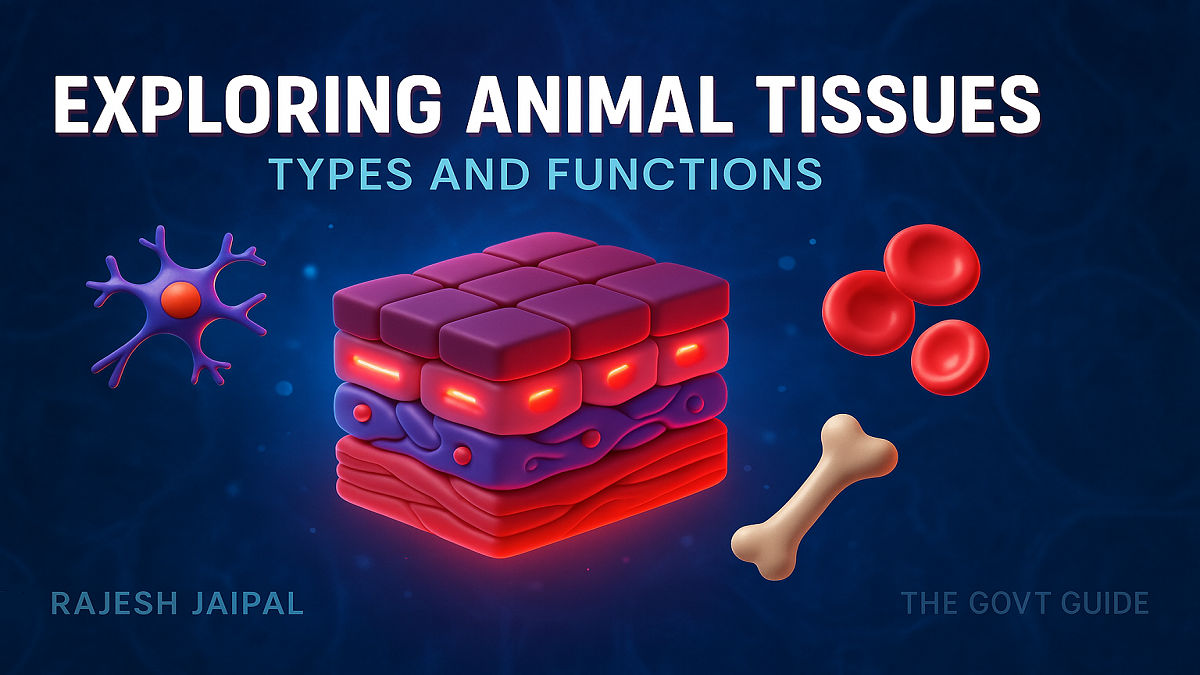Exploring Animal Tissues: Types and Functions
Exploring Animal Tissues: Types and Functions

Animals are complex organisms, and their ability to move, breathe, and function relies on specialized groups of cells called animal tissues. This article explores the four main types of animal tissues—epithelial, connective, muscular, and nervous—and their vital roles. Perfect for students and biology enthusiasts, this guide will enhance your understanding of animal biology.
What Are Animal Tissues?
Animal tissues are groups of cells with similar structures and functions that work together to perform specific tasks. Unlike plants, animals are mobile, requiring tissues that support movement, protection, and communication. Let’s explore the four main types of animal tissues.
Types of Animal Tissues
Each type of animal tissue is uniquely adapted to its function. Below, we break down the four categories and their roles.
Epithelial Tissue: The Protective Layer
Epithelial tissues cover organs and cavities, acting as a barrier. They are tightly packed with minimal intercellular spaces and rest on a basement membrane. Different types include:
- Squamous Epithelium: Thin, flat cells for diffusion (e.g., lung alveoli).
- Stratified Squamous: Layered for protection (e.g., skin).
- Columnar Epithelium: Tall cells for absorption (e.g., intestine).
- Ciliated Columnar: With cilia for movement (e.g., respiratory tract).
- Cuboidal Epithelium: Cube-shaped for support (e.g., kidney tubules).
Connective Tissue: The Support System
Connective tissues support and connect body parts, with cells embedded in a matrix. Types include:
- Blood: Fluid matrix (plasma) with RBCs, WBCs, and platelets for transport.
- Bone: Hard matrix with calcium for structural support.
- Cartilage: Flexible matrix for joint cushioning.
- Ligaments and Tendons: Elastic or fibrous for connecting bones or muscles.
- Areolar and Adipose: Loose tissue for support and fat storage.
Muscular Tissue: The Movement Makers
Muscular tissues, composed of muscle fibers with contractile proteins, enable movement. They are divided into:
- Striated (Skeletal) Muscle: Voluntary, cylindrical, multinucleate for limb movement.
- Smooth Muscle: Involuntary, spindle-shaped, uninucleate for organ movement.
- Cardiac Muscle: Involuntary, branched, uninucleate for heart contractions.
Nervous Tissue: The Communication Network
Nervous tissue, composed of neurons, transmits stimuli rapidly. Each neuron has a cell body, axon, and dendrites, enabling communication across the brain, spinal cord, and nerves.
Summary of Animal Tissues
| Tissue Type | Function |
|---|---|
| Epithelial | Protection, secretion, absorption |
| Connective | Support, transport, storage |
| Muscular | Movement and contraction |
| Nervous | Stimulus transmission |
Frequently Asked Questions (FAQs)
What is an animal tissue?
An animal tissue is a group of cells with similar structure and function, such as epithelial or muscular tissue.
What is epithelial tissue?
Epithelial tissue covers organs and cavities, acting as a protective barrier or facilitating absorption.
What is squamous epithelium?
Squamous epithelium consists of thin, flat cells for diffusion, found in lung alveoli and blood vessels.
What is connective tissue?
Connective tissue supports and connects body parts, including blood, bone, cartilage, and adipose tissue.
What is the role of blood?
Blood transports oxygen, nutrients, and waste materials throughout the body.
What are ligaments?
Ligaments are elastic connective tissues that connect bones to bones.
What are tendons?
Tendons are fibrous connective tissues that connect muscles to bones.
What is cartilage?
Cartilage is a flexible connective tissue that cushions joints and is found in the nose and ears.
What is muscular tissue?
Muscular tissue, made of muscle fibers, enables movement through contraction and relaxation.
What are striated muscles?
Striated muscles are voluntary, cylindrical, and multinucleate, used for limb movement.
What are smooth muscles?
Smooth muscles are involuntary, spindle-shaped, and uninucleate, found in organs like the intestine.
What is cardiac muscle?
Cardiac muscle is involuntary, branched, and uninucleate, responsible for heart contractions.
What is nervous tissue?
Nervous tissue, made of neurons, transmits stimuli rapidly across the body.
What is a neuron?
A neuron is a nerve cell with a cell body, axon, and dendrites, enabling signal transmission.
How do animal tissues differ from plant tissues?
Animal tissues support movement and complex systems, while plant tissues focus on support and transport due to their stationary nature.
Conclusion
Animal tissues are essential for the diverse functions that enable movement, protection, and communication in animals. From epithelial barriers to muscular contractions and neural signaling, each tissue type is uniquely adapted. Dive deeper into biology with our guide on plant tissues or explore Tissue for more resources.
Call to Action: Try observing blood cells under a microscope or share your insights in the comments!
Join the conversation